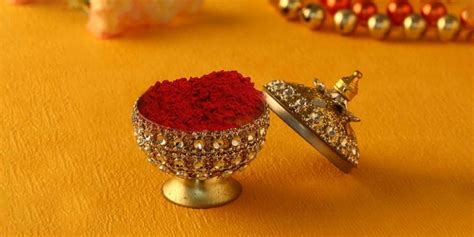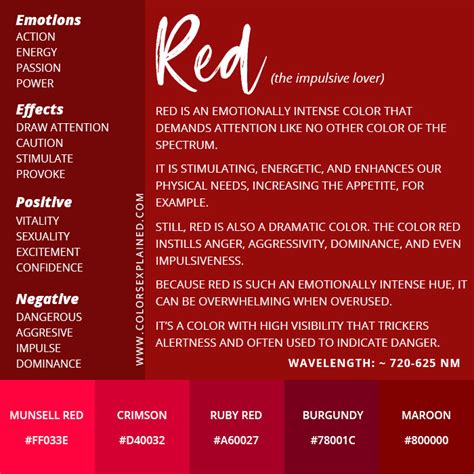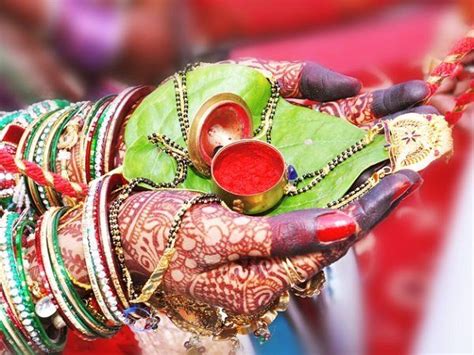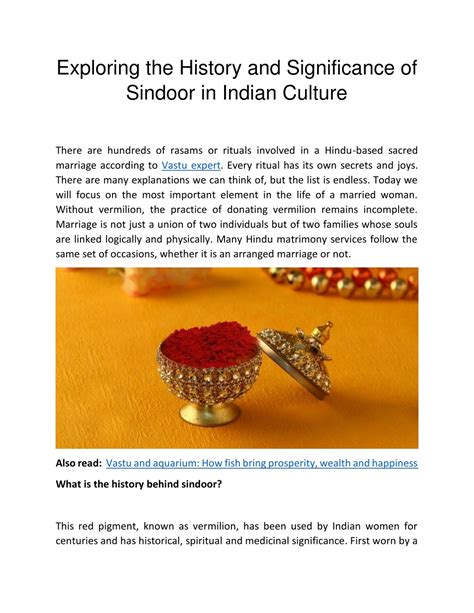Throughout history, humans have been captivated by the deep-rooted desire to express themselves through various forms of adornment. From intricate jewelry to elaborate tattoos, each embellishment carries its own symbolism and holds a unique interpretation. Among the plethora of adornments, the act of applying vermilion powder, known as Sindoor, on the forehead has fascinated individuals across cultures.
This mark, revered and cherished by many, carries with it a hidden language that transcends words. Its significance lies not only in the physical act of application but also in the emotions and beliefs it evokes. This ancient practice has been passed down through generations, carrying with it a sense of tradition and cultural identity.
Referred to by different names in various regions of the world, the act of adorning the forehead with Sindoor represents an unspoken agreement between individuals and the transcendent forces of the universe. It embodies the understanding of one's place in the world, the relationship between the mortal and the divine.
With a simple stroke of vermilion, an individual becomes part of an intricate web of symbols and meanings. The vibrant red hue of Sindoor signifies the energy and passion that flows through life. It is a manifestation of the fire within, the fierce determination to embrace one's desires and aspirations. The bold stroke of color acts as a reminder of the strength and resilience that lies within each individual.
Exploring the Significance of Sindoor in Hindu Traditions

In this section, we delve into the profound importance of Sindoor within the rich tapestry of Hindu traditions. This vermilion pigment holds deep symbolism in various aspects of Hindu culture, encompassing marriage, spirituality, purity, and devotion. Examining the historical and cultural contexts surrounding Sindoor allows us to appreciate its multifaceted significance and explore the rituals and customs associated with its use.
One of the primary elements entwined with Sindoor is its association with marriage. Considered an essential adornment for married Hindu women, the application of Sindoor on the parting of the hair symbolizes a woman's marital status and commitment to her spouse. It is believed to invoke the blessings of Goddess Parvati, who is revered as the ideal wife in Hindu mythology. This vibrant red pigment is seen as an auspicious mark of a woman's devotion and is regarded as a visual expression of love, loyalty, and fertility.
Beyond its matrimonial significance, Sindoor also holds spiritual connotations within Hindu traditions. It is often applied as part of religious rituals and ceremonies, signifying devotion to deities and invoking their divine blessings. By adorning the forehead with Sindoor, individuals seek to awaken their spiritual consciousness and establish a stronger connection with the divine. It is believed to enhance spiritual purity and elevate one's consciousness, serving as a reminder of the ultimate goal of self-realization.
The significance of Sindoor extends beyond just its association with marriage and spirituality. In various Hindu festivals and celebrations, the application of Sindoor plays a significant role. During festivals like Karva Chauth and Durga Puja, married women apply Sindoor as a symbol of their devotion and seek the well-being and longevity of their husbands. Additionally, the vibrant red of Sindoor is considered auspicious and is often used in auspicious ceremonies and auspicious occasions, symbolizing good fortune and prosperity.
As we explore the significance of Sindoor in Hindu traditions, it becomes evident that this vermilion pigment represents far more than a mere cosmetic adornment. It serves as a powerful symbol of love, commitment, spirituality, and tradition within Hindu culture. By understanding its deep-rooted meanings and customs, we can gain a deeper appreciation for the cultural heritage and beliefs associated with the beautiful tradition of applying Sindoor.
An Ancient Tradition: Origins and History of Vermilion Powder
The rich history and origins of vermillion powder, an adornment used in traditional Southeast Asian cultures, elicit fascination and curiosity. This ancient tradition has been passed down through generations, carrying deep symbolism and cultural significance in various societies.
Vermillion powder, also known as sindoor or kumkum, holds a prominent place in ceremonies, rituals, and daily life. Its historical roots can be traced back centuries, establishing a profound connection to cultural practices and beliefs.
Throughout history, vermillion powder has been used as a visual marker of a married woman in many cultures. It is traditionally applied on the parting line of a woman's hair, symbolizing her marital status and conjugal happiness. The bright red color of sindoor represents passion, marital bliss, and commitment.
Originating from ancient Hindu texts, such as the Rigveda and Manusmriti, sindoor has been an integral part of Vedic rituals and traditions. It was believed to protect the husband and his family from negative energy and bring prosperity and longevity to the marriage.
Furthermore, the application of sindoor is not limited to Hindu culture. It is also an important adornment in Sikhism and other communities in South Asia. The cultural variations and interpretations surrounding this vibrant powder make its history even more diverse and intriguing.
The usage of sindoor has evolved over time, adapting to the changing social and cultural landscapes. Today, it is not only seen as a symbol of marriage but also a representation of pride, tradition, and empowerment for many women.
As we delve deeper into the history of vermillion powder, we gain insights into the rich traditions and rituals that have shaped and preserved this ancient custom. Exploring its origins allows us to appreciate the cultural heritage and significance of sindoor in varying societies.
In conclusion, the history of sindoor is a testament to the enduring nature of cultural practices and their ability to transcend borders and time. Understanding the origins and evolution of this ancient tradition provides a glimpse into the vibrant tapestry of Southeast Asian cultures.
The Color Red: Symbolic Meanings and Associations

Exploring the significance of the color red unveils a plethora of symbolic meanings and associations that have transcended cultures, time, and boundaries. This vibrant hue has long been associated with various emotions, concepts, and symbolic representations throughout history.
In many cultures, red is synonymous with passion, love, and desire. It evokes feelings of intense emotions, romantic love, and fiery passion. The color's association with love can be traced back to ancient civilizations, where it was often used to represent the goddess of love and fertility.
Red is also often linked to power, strength, and courage. It is associated with vitality, energy, and determination. This association stems from the color's connection to fire, which symbolizes vigor and action. Many societies view red as a color that represents leadership, assertiveness, and confidence.
| Symbolic Meanings of Red: | Associations of Red: |
|---|---|
| Love | Passion |
| Energy | Strength |
| Power | Courage |
| Vitality | Determination |
| Intense emotions | Romantic love |
Furthermore, red is often associated with luck, prosperity, and celebration in many cultures. It is frequently used in festive occasions and ceremonies to symbolize good fortune and happiness. This connection to luck and abundance can be observed in traditions such as the use of red envelopes in Chinese culture during the Lunar New Year.
Lastly, the color red holds deep religious and spiritual significance in various faiths and belief systems. It is frequently associated with power, divinity, and sacredness. In some religions, red represents sacrifice, martyrdom, and salvation, while in others, it is a symbol of purification and spiritual awakening.
In conclusion, the color red is a rich and multifaceted symbol that carries various meanings and associations. From love and passion to power and spirituality, this vibrant hue has a profound impact on our emotions, cultures, and beliefs.
Expressions of Love and Commitment Reflected in the Application of Sindoor
Within the cultural context of South Asia, the act of applying sindoor represents a profound expression of love, devotion, and commitment in the realm of marriage. This vibrant red powder has long been synonymous with the sacred bond between a husband and wife, symbolizing both the emotional connection and the societal recognition of their union. Sindoor holds an immense significance as a powerful visual marker, reflecting the deep-rooted cultural beliefs and traditions surrounding love and marriage.
Through the application of sindoor, individuals convey their unwavering dedication to their spouse and the eternal nature of their relationship. The bright red hue of sindoor evokes feelings of passion, desire, and intense affection, visually epitomizing the fervent emotions that accompany the bond of marriage. It serves as a visible testament to the couple's commitment to each other, reminding them of the love that binds them together and the promises they have made to each other.
In addition to its significance as a symbol of love, sindoor also carries immense cultural and societal weight. It serves as a public declaration of a woman's marital status and her inclusion within the married community. The presence of sindoor on a woman's forehead signifies her commitment to her husband and her acceptance of her role as a wife. It acts as a visual marker of her devotion and loyalty, a signal to society that she is no longer available for marriage and is dedicated to her chosen life partner.
| Love and Unity | By applying sindoor, couples reinforce their bond and express their unity as they embark on their journey of marriage. |
| Tradition and Heritage | The application of sindoor upholds cultural traditions and reinforces the importance of preserving one's heritage in the realm of love and marriage. |
| Commitment and Devotion | The presence of sindoor signifies an unwavering commitment and deep-seated devotion between spouses, reflecting the enduring nature of their relationship. |
| Social Recognition | Sindoor acts as a societal marker, proclaiming a woman's marital status and affirming her place within the married community. |
In conclusion, the application of sindoor holds powerful expressions of love and marriage in the South Asian cultural context. It embodies the emotions of passion and devotion, while fulfilling societal expectations and recognizing the sacred bond between a husband and wife. Sindoor acts as a visual testament to the deep-seated commitment and enduring love that exists within a marriage, creating a powerful symbol of unity and partnership.
Spiritual Significance: Sindoor as a Symbol of Devotion

In the realm of spiritual expression and symbolisms, there exists a profound significance behind the application of sindoor on the forehead. This sacred practice permeates various cultures and holds the power to portray the depths of devotion and spiritual connection. Far beyond the realm of materiality, sindoor serves as a tangible representation of profound reverence and unwavering commitment.
As a symbol of devotion, the application of sindoor carries deep spiritual connotations. It signifies an individual's unwavering dedication towards their chosen deity, embodying the essence of surrender and complete subjugation. Just as sindoor adorns the forehead, it becomes a testament to the devotee's willingness to submit to a higher power and embrace the spiritual journey.
Furthermore, sindoor represents the manifestation of spiritual union. It transcends physicality and delves into the realm of inner love and oneness with the divine. Through the act of adorning sindoor, individuals align themselves with the cosmic energy, seeking solace and spiritual fulfillment. This symbolism reinforces the belief that true devotion can transform an ordinary existence into a sacred and spiritual endeavor.
Moreover, the crimson hue of sindoor holds symbolic significance in its own right. It symbolizes the passionate and intense nature of the devotee's commitment to their spiritual path. The color red embodies vitality, fervor, and immense love, all of which are essential components of a truly devotional life. Creating a visual tapestry of dedication, sindoor serves as a vivid testament to the vibrant spiritual landscape residing within the heart and soul of an individual.
Ultimately, the act of adorning sindoor on the forehead transcends cultural boundaries and embraces individuals from various walks of life who share a common yearning for spiritual connection. It ignites the flame of devotion within, reminding one of their commitment to a higher purpose. Sindoor, in all its symbolic glory, reminds us that true devotion is an art, a journey of the soul, and an unwavering dedication to inner transformation.
Exploring the Meaning Behind Dreams of Adorning the Vermilion
Delve into the depths of subconscious desires and unravel the hidden messages conveyed through dreams where one finds themselves adorned with the vibrant red pigment known as Sindoor. These visions within the realm of slumber hold profound significance and can offer insights into one's emotions, relationships, and spiritual aspirations. By deciphering the symbolic implications behind the act of applying Sindoor, we can gain a deeper understanding of these dreams and their impact on our waking lives.
1. Emotional Fulfillment: Dreams of wearing Sindoor may represent a yearning for emotional fulfillment or the manifestation of deep emotional connections. Just as the striking red hue symbolizes passion and love, the dreamer's desire for emotional intimacy and harmony with their partner or loved ones may be reflected in their dream state.
2. Commitment and Devotion: The act of adorning one's forehead with Sindoor carries strong connotations of commitment and devotion in traditional Indian culture. Dreams featuring this ritualistic application may indicate a deep sense of loyalty, dedication, and devotion towards a specific person, cause, or belief system. Such dreams may serve as reminders to nurture and honor these commitments in waking life.
3. Expression of Identity: Dreams of wearing Sindoor can also symbolize the dreamer's desire for self-expression and recognition of their cultural or religious identity. It may reflect a longing to embrace and celebrate one's heritage, traditions, and values, urging the individual to explore their roots more deeply and find pride in their unique identity.
4. Transformation and Spiritual Awakening: In some interpretations, dreams involving Sindoor may signify a spiritual awakening or a transformative journey. The application of this auspicious vermilion pigment can represent the individual's initiation into a new phase of spiritual growth, enlightenment, or self-realization. Such dreams may encourage the dreamer to embrace inner change, seek spiritual guidance, and embark upon a path of personal transformation.
By unraveling the symbolism hidden within dreams of wearing Sindoor, one can gain valuable insights into their subconscious desires, emotional needs, and spiritual aspirations. Such dreams serve as a catalyst for self-reflection and personal growth, providing a window into the deeper layers of the dreamer's psyche and guiding them towards a more fulfilling and meaningful existence.
Exploring the Significance of Dreams Manifesting Sindoor Application: Gaining Insights into Emotional Well-being

In the realm of dreams, the act of applying sindoor holds profound symbolic meaning and offers valuable insights into one's emotional state. The subconscious mind weaves a tapestry of symbols and images, allowing us to explore the depths of our emotions, desires, and anxieties. When dreaming of applying sindoor, one is provided with a unique opportunity to delve into their emotional well-being, uncovering hidden truths and gaining a deeper understanding of their innermost feelings.
Unveiling the Symbolism: Within the context of dream analysis, the act of applying sindoor represents a powerful expression of personal identity, cultural heritage, and emotional connection. It serves as a visual symbol of commitment, passion, and devotion, and holds significance in various cultural and religious contexts. When this imagery emerges in a dream, it invites exploration of the dreamer's emotional landscape, offering a roadmap to understanding their desires, attachments, and overall state of contentment or dissatisfaction.
Empowering Self-Reflection: Dreaming of applying sindoor carries an invitation to engage in introspection and self-reflection. By contemplating the emotions evoked during this dream scenario, one can gain valuable insights into their own emotional well-being. It prompts contemplation of personal relationships, the presence or absence of commitment, the resilience of emotional bonds, and the overall satisfaction within one's life. This introspective journey allows individuals to identify areas of personal growth, recognize unfulfilled desires, and take necessary steps towards emotional fulfillment.
Unearthing Hidden Desires: Dreams featuring the application of sindoor possess the potential to unearth dormant desires, often associated with love, companionship, and commitment. The symbolism of sindoor is deeply rooted in notions of intimacy and deep emotional connections. Therefore, when this imagery is present in a dream, it serves as a gentle reminder to nurture and explore these desires within oneself. It encourages individuals to acknowledge and honor their emotional needs, prompting actions that lead to the fulfillment of these desires.
A Catalyst for Emotional Healing: Dreams manifesting the application of sindoor act as a catalyst for emotional healing and growth. By bringing forth imagery that symbolizes devotion and emotional commitment, these dreams offer an opportunity to resolve emotional conflicts, heal wounds, and strengthen interpersonal connections. Recognizing the emotions evoked during these dream scenarios empowers individuals to address unresolved issues, engage in open communication, and embark on a journey of emotional healing and growth.
In conclusion, dreams depicting the act of applying sindoor encompass a rich tapestry of meaning. They invite individuals to explore their emotional well-being, delve into their desires, and embark on a path of emotional healing. By embracing the symbolism and insights offered by these dreams, individuals can navigate their emotional landscapes with greater awareness and cultivate a fulfilling and harmonious inner world.
The Influence of Cultural Context: Varied Interpretations of Vermilion Dreams
Within the realm of dream symbolism, dreams about applying vermilion on the forehead hold significant meaning and intricate interpretations. These vivid nocturnal experiences can have diverse connotations depending on one's cultural heritage and contextual background. By examining the influence of cultural context on the understanding and interpretation of vermilion dreams, we gain a deeper understanding of how symbolic meanings can shift and evolve.
Symbolism, as a means of communication, is deeply rooted in cultural traditions and customs. In some cultures, the act of applying vermilion to the forehead represents auspiciousness, marital bliss, and fertility. This vibrant red pigment signifies the bond between a married woman and her husband, representing their love, commitment, and prosperity. However, in other cultural contexts, vermilion dreams may denote something entirely different.
Furthermore, the interpretation of vermilion dreams can vary based on the societal and historical contexts in which they are situated. For instance, in certain cultural settings, vermilion dreams might symbolize spiritual devotion and connection with deities or higher powers. This association stems from ancient rituals where vermilion was used to mark the forehead during religious ceremonies, linking the wearer to their faith and spiritual beliefs.
Additionally, the influence of personal experiences and individual perspectives cannot be overlooked when it comes to understanding vermilion dreams. Dreams are uniquely personal, and while cultural and historical contexts play a significant role, the interpretation of a vermilion dream can also be shaped by an individual's emotions, desires, and subconscious thoughts. What may symbolize good fortune for one person might represent longing or unfulfilled aspirations for another.
In conclusion, the interpretation of vermilion dreams is not a one-size-fits-all concept, but rather an intricate interplay of cultural, societal, and personal influences. Exploring the varied interpretations of vermilion dreams within different cultural contexts sheds light on the richness and diversity of symbolic meanings associated with this vibrant and profound practice.
FAQ
What is the significance of wearing sindoor on the forehead?
Wearing sindoor on the forehead holds immense significance in various cultures, particularly in Hinduism. It represents a married woman's commitment, love, and dedication towards her husband. It is also believed to bring luck and prosperity to the married couple.
Why do women in India wear sindoor only after marriage?
In Indian culture, sindoor is considered a symbol of marital status. It is believed that a woman becomes complete and her identity as a married woman is recognized when she applies sindoor on her forehead. Therefore, it is customary for women to wear sindoor only after their marriage.
What is sindoor made of? Is it safe to use?
Sindoor is typically made from a mixture of turmeric, saffron, limestone, and other natural ingredients. However, nowadays, synthetic sindoor is also available in the market. It is generally safe to use sindoor made from natural ingredients, but it is important to be cautious while purchasing synthetic sindoor as it may contain chemicals that can be harmful.
Do all Hindu women wear sindoor? What about women from other religions?
No, wearing sindoor is not a mandatory practice for all Hindu women. It is a personal choice and varies from woman to woman. Sindoor is not worn by women belonging to other religions, as it holds religious and cultural significance mainly within Hindu traditions.



